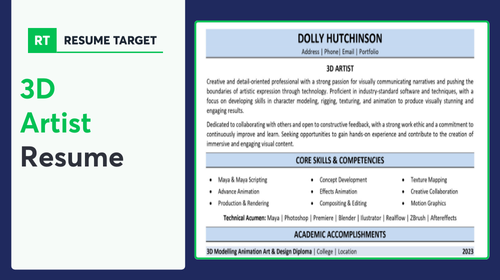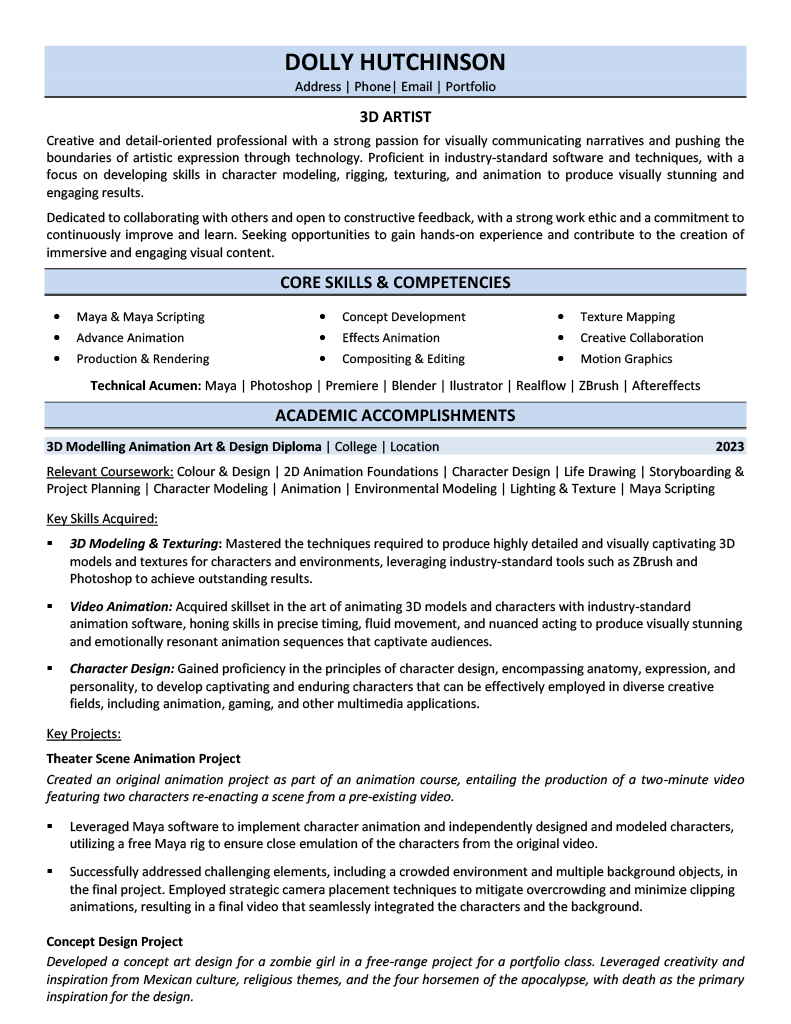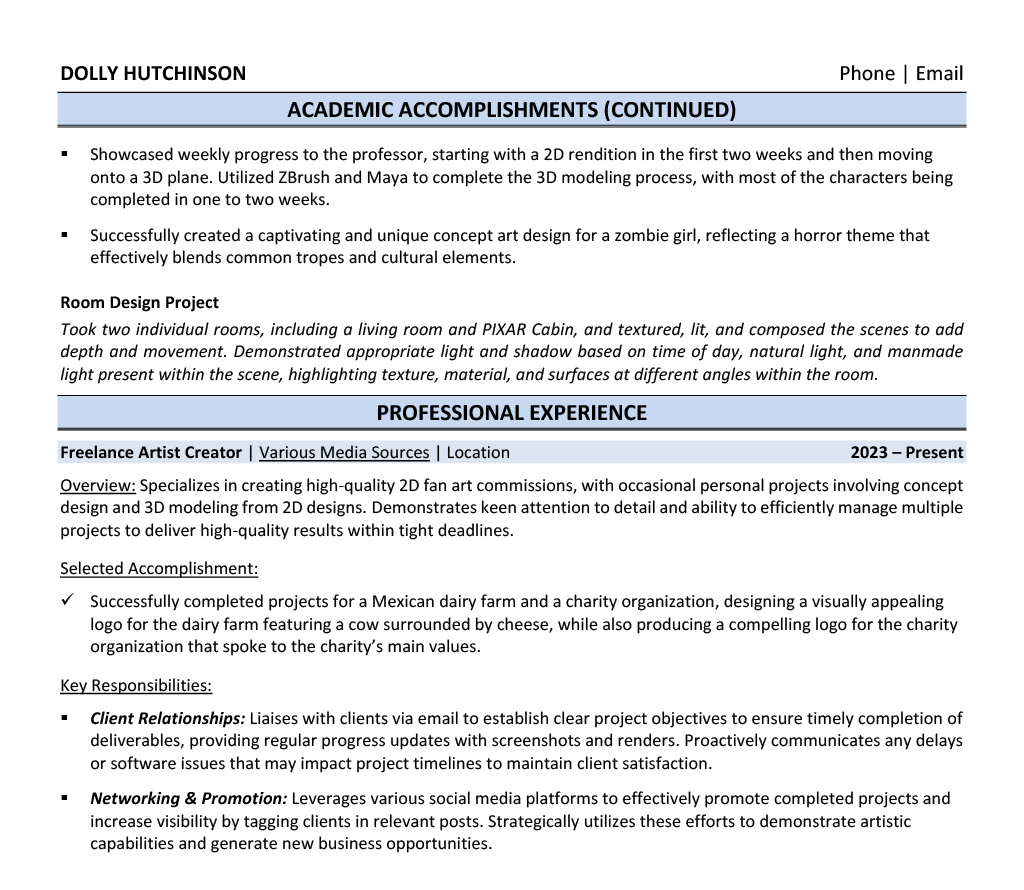

Stunning 3D portfolios don't always translate to stunning resumes. Many talented 3D artists struggle to describe their technical mastery and creative achievements in words that hiring managers understand.
Are you finding it challenging to showcase both your artistic vision and technical expertise on paper? Your resume needs to bridge the gap between creative portfolio work and business impact, speaking directly to what studios and agencies want.
At Resume Target, we understand how to translate complex 3D projects into compelling career stories. We help artists like you craft resumes that showcase your technical skills, creative achievements, and business value in language that resonates with hiring decision-makers.


At the intersection of art and technology, 3D Artists are digital sculptors who transform blank computer screens into vibrant virtual worlds, creating everything from immersive visual experiences in entertainment, film, and advertising.
Using specialized software like Maya, Blender, and ZBrush, these digital craftspeople model three-dimensional objects, craft detailed textures, and manipulate virtual lighting to bring imagination to reality, whether they're designing product prototypes, animated characters, or architectural visualizations.
As the demand for 3D content explodes across gaming, metaverse platforms, and augmented reality applications, your journey as a 3D Artist can branch into countless exciting specializations, from character modeling to environmental design to visual effects supervision.
Let's talk about what's exciting in the 3D Artist field - your creative talents can unlock impressive earning potential! As you progress from entry-level to senior positions, your compensation can nearly triple, making this an incredibly rewarding career path for talented visual artists like you.
Figures from: Jobicy Salary Guide
3D Artists can advance from junior positions to specialized roles in gaming, film, or animation. Your career path might lead you from basic modeling to becoming a Creative Director or Art Director.
To accelerate your career growth, you'll need to master both technical tools and professional soft skills that set you apart in the competitive 3D art industry.
- Mastery of Maya, Blender, and ZBrush - Advanced 3D modeling and rigging techniques - Game engine expertise (Unity, Unreal) - Creative problem-solving and team leadershipBreaking into the 3D artist field starts with mastering core software like Maya and Blender, building a standout portfolio, and gaining hands-on experience through entry-level positions or freelance work.
To advance in your 3D artist career, you'll need to develop both technical expertise and essential soft skills, with creative problem-solving and effective communication being particularly crucial for success in collaborative projects.
Requirements from URL WEBSITE NAME
From Hollywood studios to game developers, 3D Artists are in demand across tech and entertainment hubs nationwide.
Figures from U.S. Bureau of Labor Statistics
Struggling to showcase your creative portfolio, technical skills, and artistic achievements all on one resume that will catch a hiring manager's eye? This comprehensive, section-by-section guide will help you craft a 3D Artist resume that perfectly balances your artistic talents with your technical expertise.
As a creative professional who brings digital worlds to life, you know crafting the perfect resume summary can feel just as challenging as nailing complex character rigging or texture mapping.
While you excel at transforming concepts into stunning 3D visuals using Maya, ZBrush, and other tools, capturing your artistic and technical expertise in a few compelling sentences requires a different kind of artistry that speaks directly to hiring managers' needs.
How would you describe your unique artistic style and technical expertise in 3D modeling, texturing, and animation that sets you apart from other 3D artists?
Reason: This helps establish your creative identity while highlighting your core technical competencies, allowing recruiters to quickly understand your artistic approach and technical foundation.
What industries and types of 3D projects have shaped your professional journey, and how has this diverse experience influenced your current capabilities?
Reason: This question helps you articulate your professional evolution and versatility, showing potential employers the breadth of your experience and adaptability across different 3D applications.
How do you balance artistic vision with technical constraints while maintaining efficiency in your workflow and meeting production deadlines?
Reason: This helps you demonstrate your practical understanding of production realities and your ability to deliver both creative and technically sound solutions within professional environments.
As a 3D artist, you'll need to showcase both your technical mastery of industry-standard software like Maya, ZBrush, and Substance Painter, alongside your creative abilities in modeling, texturing, and animation.
Your skills section should balance essential production tools (like UV mapping and rigging) with artistic competencies (such as lighting and composition), while also highlighting any specialized skills like character design or environmental modeling that set you apart.
Showcase your creative journey as a 3D artist by organizing your experience into three impactful sections: your role overview highlighting the studios and projects you've shaped, your standout achievements with metrics and portfolio highlights, and your core technical responsibilities that demonstrate your mastery of 3D tools and workflows.
Many 3D Artists struggle to demonstrate their technical expertise and creative impact beyond just listing software proficiency and completed projects. Transform your achievements section by connecting your artistic innovations and technical solutions to measurable business metrics like rendering efficiency, production timelines, and client satisfaction rates.
The responsibilities section demonstrates how 3D Artists contribute to visual storytelling and product development beyond basic modeling tasks. Your role description should help non-technical hiring managers understand how your creative and technical skills drive project success and enhance the final product's visual appeal.
Your formal education and technical certifications demonstrate your expertise in 3D modeling, animation, and digital art creation. List your most relevant qualifications first, especially those involving industry-standard software like Maya, ZBrush, or 3ds Max, and include any specialized training in areas like character design or environmental modeling.
Now that you've built a strong foundation using Resume Target's comprehensive resume writing guidelines, you're ready to transform your basic resume into a powerful portfolio piece that showcases your artistic talents.
While many 3D artists focus solely on perfecting their demo reels and portfolios, a customized resume that speaks directly to each studio's unique creative vision and technical requirements can be the difference between landing an interview or being overlooked.
By strategically incorporating specific software proficiencies, art styles, and industry-specific keywords from each job posting, your resume will not only sail through ATS screenings but will also demonstrate to creative directors that you understand and align with their project needs.
Ready to turn your resume into your secret weapon? Let's transform it into a compelling narrative that proves you're not just another 3D artist – you're exactly the creative talent they've been searching for!
Don't let a lack of professional experience hold you back from launching your career as a 3D Artist!
Instead of dwelling on unrelated work history, you can build an impressive resume by showcasing your education, technical skills, and most importantly - your portfolio of 3D modeling projects and internships.
Your resume should emphasize three key elements: your software proficiency, completed projects/portfolio pieces, and relevant coursework or certifications.
For more guidance on structuring your creative resume, check out the Student Resume Writing Guide to help highlight your artistic talents and technical abilities.
Your creative portfolio and technical expertise deserve center stage in your summary, even without years of professional experience.
Focus on showcasing your software proficiency, completed projects, and the unique artistic perspective you bring to 3D design and animation.
"Creative and technically skilled 3D Artist with extensive training and hands-on experience in Maya, Blender, and ZBrush through academic projects and freelance work. Proficient in creating detailed character models, environmental assets, and animations with a keen eye for lighting and texturing. Successfully completed 5 collaborative gaming projects and maintained a digital portfolio showcasing diverse artistic capabilities. Seeking to leverage strong 3D modeling skills and artistic vision to create compelling visual content for a forward-thinking gaming studio."
Now's your chance to showcase the specialized training and hands-on experience that makes you stand out as a 3D artist - from formal degrees to industry-specific certifications!
Transform your educational background into compelling content by highlighting relevant coursework like "Advanced Character Modeling"or innovative portfolio projects that demonstrate your mastery of industry-standard software and creative techniques.
Common courses for a 3D Artist include a range of subjects such as 3D Modeling, 3D Animation, Digital Painting, and more, alongside certifications related to popular software.Relevant Coursework: 3D Modeling | Digital Sculpting | Character Animation | Texture Mapping | Digital Painting | Visual Effects
Key Projects:
Character Design Pipeline Project: Developed a fully rigged and textured 3D character from concept to final render, demonstrating comprehensive understanding of the entire production workflow.
Collaborative Animation Short: Led a team of four artists to create a 30-second animated sequence for a student showcase, focusing on environmental modeling and lighting.
Leverage your academic training, software proficiencies, and creative portfolio work to showcase the dynamic blend of technical and artistic abilities that make you stand out as an emerging 3D artist.
As an entry-level 3D artist, your combination of technical expertise and creative vision positions you well for roles in gaming, animation, visualization, or other exciting digital media sectors that continue to grow and evolve.
Let's face it - showcasing your creative portfolio is one thing, but capturing the full scope of your technical expertise, artistic vision, and project impact in a traditional resume format can feel like trying to fit a 3D world into a 2D box.
At Resume Target, we understand the unique intersection of creativity and technology that defines successful 3D artists, having helped countless professionals showcase everything from character rigging expertise to rendering optimization achievements.
Our deep knowledge of the arts industry means we know exactly how to position your skills to catch a creative director's eye.
With studios actively staffing up for next year's major projects, now is the perfect time to transform your resume into a powerful career tool - connect with us today to start standing out in a competitive field.
Impress any hiring manager with our arts resume writing service. We work with all career levels and types of arts professionals.
Learn More → Arts Resume Writing Services